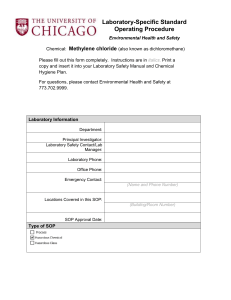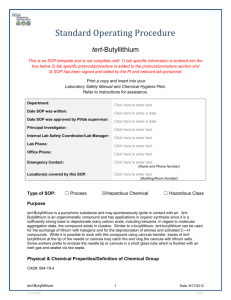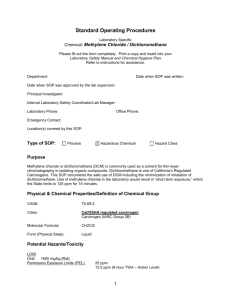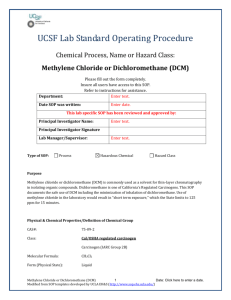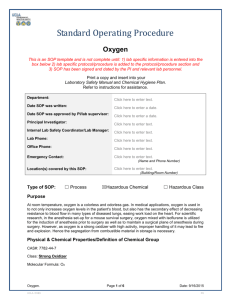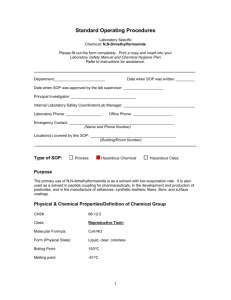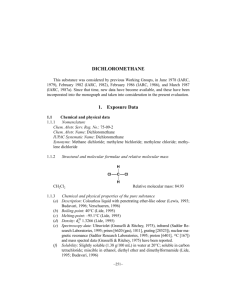Dichloromethane - UCLA David Geffen School of Medicine
advertisement
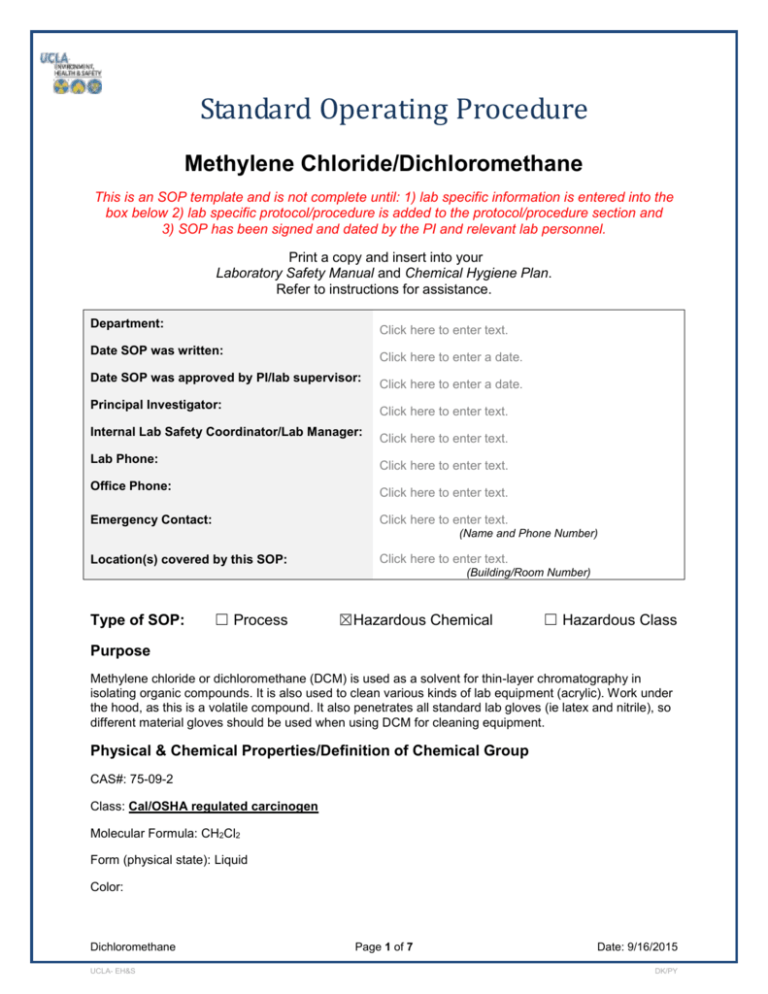
Standard Operating Procedure Methylene Chloride/Dichloromethane This is an SOP template and is not complete until: 1) lab specific information is entered into the box below 2) lab specific protocol/procedure is added to the protocol/procedure section and 3) SOP has been signed and dated by the PI and relevant lab personnel. Print a copy and insert into your Laboratory Safety Manual and Chemical Hygiene Plan. Refer to instructions for assistance. Department: Click here to enter text. Date SOP was written: Click here to enter a date. Date SOP was approved by PI/lab supervisor: Principal Investigator: Click here to enter text. Internal Lab Safety Coordinator/Lab Manager: Lab Phone: Click here to enter a date. Click here to enter text. Click here to enter text. Office Phone: Click here to enter text. Emergency Contact: Click here to enter text. (Name and Phone Number) Location(s) covered by this SOP: Click here to enter text. (Building/Room Number) Type of SOP: ☐ Process ☒Hazardous Chemical ☐ Hazardous Class Purpose Methylene chloride or dichloromethane (DCM) is used as a solvent for thin-layer chromatography in isolating organic compounds. It is also used to clean various kinds of lab equipment (acrylic). Work under the hood, as this is a volatile compound. It also penetrates all standard lab gloves (ie latex and nitrile), so different material gloves should be used when using DCM for cleaning equipment. Physical & Chemical Properties/Definition of Chemical Group CAS#: 75-09-2 Class: Cal/OSHA regulated carcinogen Molecular Formula: CH2Cl2 Form (physical state): Liquid Color: Dichloromethane UCLA- EH&S Page 1 of 7 Date: 9/16/2015 DK/PY Boiling point: Potential Hazards/Toxicity LD50 Oral: 1600 mg/kg [Rat] Permission Exposure Limits (PEL): 25 ppm 12.5 ppm (8-hour TWA – Action Level) Acute Effects Very hazardous in case of eye contact (irritant), of ingestion, of inhalation. In case of ingestion, DCM may cause irritation of the gastrointestinal tract with vomiting. If vomiting results in aspiration, chemical pneumonia could follow. Absorption through gastrointestinal tract may produce symptoms of central nervous system depression ranging from light headedness to unconsciousness. Hazardous in case of skin contact (irritant, permeator). Inflammation of the eye is characterized by redness, watering, and itching. Eye contact may cause temporal eye damage. Chronic Effects Can cause headache, mental confusion, depression, liver effects, kidney effects, bronchitis, loss of appetite, nausea, lack of balance, and visual disturbances. Can cause dermatitis upon prolonged skin contact. Mutagenic Effects Methylene chloride may cause cancer in humans. Developmental Toxicity The substance is toxic to lungs, the nervous system, liver, mucous membrane Personal Protective Equipment (PPE) Respiratory Protection Respirators should be used only under any of the following circumstances: As a last line of defense (i.e., after engineering and administrative controls have been exhausted). When Permissible Exposure Limit (PEL) has exceeded or when there is a possibility that PEL will be exceeded. Regulations require the use of a respirator. An employer requires the use of a respirator. There is potential for harmful exposure due to an atmospheric contaminant (in the absence of PEL) As PPE in the event of a chemical spill clean-up process Lab personnel intending to use/wear a respirator mask must be trained and fit-tested by EH&S. This is a regulatory requirement. (https://www.ehs.ucla.edu/ep/ih/resp) Hand Protection Nitrile gloves. Gloves must be inspected prior to use. Use proper glove removal technique (without touching glove's outer surface) to avoid skin contact with this product. Dispose of contaminated gloves after use in accordance with applicable laws and good laboratory practices. Wash and dry hands. NOTE: Consult with your preferred glove manufacturer to ensure that the gloves you plan on using are compatible with dichloromethane. Refer to glove selection chart from the links below: http://www.ansellpro.com/download/Ansell_8thEditionChemicalResistanceGuide.pdf Dichloromethane UCLA- EH&S Page 2 of 7 Date: 9/16/2015 DK/PY OR http://www.allsafetyproducts.com/glove-selection-chart-chemical-breakthrough-ratings.html OR http://www.showabestglove.com/site/default.aspx OR http://www.mapaglove.com/ Eye Protection ANSI approved safety glasses. Skin and Body Protection Lab coats should be worn. These laboratory coats must be appropriately sized for the individual and be buttoned to their full length. Laboratory coat sleeves must be of a sufficient length to prevent skin exposure while wearing gloves. Full length pants and close-toed shoes must be worn at all times by all individuals that are occupying the laboratory area. The area of skin between the shoe and ankle should not be exposed. Hygiene Measures Avoid contact with skin, eyes and clothing. Wash hands before breaks and immediately after handling the product. . Engineering Controls All operations involving methylene chloride and dilutions should be carried out in a certified chemical fume hood or a ducted Biosafety cabinet to keep airborne level below recommended exposure limits Chemical fume hoods used as containment areas for particularly hazardous chemicals must have a face velocity of 100 cfm, averaged over the face of the hood and must be certified annually. Laboratory rooms must be at negative pressure with respect to the corridors and external environment. The laboratory/room door must be kept closed at all times. Vacuum lines are to be protected by HEPA (high efficiency particulate air) filters or higher efficiency scrubbers. First Aid Procedures If inhaled If inhaled, remove to fresh air. If breathing becomes difficult, call a physician. In case of skin contact In case of contact, immediately wash skin with soap and copious amounts of water. In case of eye contact In case of contact with eyes, flush with copious amounts of water for at least 15 minutes. Assure adequate flushing by separating the eyelids with fingers. Call a physician. If swallowed If swallowed, wash out mouth with water provided person is conscious. Call a physician. Special Handling and Storage Requirements Keep in a tightly closed container, stored in a cool, dry, ventilated area. Protect against physical damage. Isolate from any source of heat or ignition. Dichloromethane UCLA- EH&S Page 3 of 7 Date: 9/16/2015 DK/PY Store in secondary containment, isolate from other chemical compounds with proper labeling: REGULATED CARCINOGEN DCM can be stored in the same cabinet as other regulated carcinogen Segregate the chemicals from incompatible materials, as described in the UCLA Safety Manual and Chemical Hygiene Plan. Spill and Accident Procedure Chemical Spill Dial 911 and x59797 Spill – Assess the extent of danger. Help contaminated or injured persons. Evacuate the spill area. Avoid breathing vapors. If possible, confine the spill to a small area using a spill kit or absorbent material. Keep others from entering contaminated area (e.g., use caution tape, barriers, etc.). Small (<1 L) – If you have training, you may assist in the clean-up effort. Use appropriate personal protective equipment and clean-up material for chemical spilled. Double bag spill waste in clear plastic bags, label and take to the next chemical waste pick-up. Large (>1 L) – Dial 911 (or 310-825-1491 from cell phone) and EH&S at x59797 for assistance. Chemical Spill on Body or Clothes – Remove clothing and rinse body thoroughly in emergency shower for at least 15 minutes. Seek medical attention. Notify supervisor and EH&S at x59797 immediately. Chemical Splash Into Eyes – Immediately rinse eyeball and inner surface of eyelid with water from the emergency eyewash station for 15 minutes by forcibly holding the eye open. Seek medical attention. Notify supervisor and EH&S at x59797 immediately. Medical Emergency Dial 911 or x52111 Life Threatening Emergency, After Hours, Weekends And Holidays – Dial 911 (or 310-825-1491 from cell phone) or contact the Ronald Reagan UCLA Medical Center (emergency room) directly at x52111 (located at 757 Westwood Plaza, enter from Gayley Avenue). Note: All serious injuries must be reported to EH&S at x59797 within 8 hours. Non-Life Threatening Emergency – Go to the Occupational Health Facility (OHF), x56771, CHS room 67-120 (This is on the 6th floor, 7th corridor, room 120. Enter through the School of Dentistry on Tiverton Drive and proceed to the “O” elevator to the 6th floor.)Hours: M - F, 7:30 a.m. to 4:30 p.m. At all other times report to Ronald Reagan UCLA Medical Center (emergency room) at x52111. Note: All serious injuries must be reported to EH&S at x59797 within 8 hours. Needle stick/puncture exposure (as applicable to chemical handling procedure) – Wash the affected area with antiseptic soap and warm water for 15 minutes. For mucous membrane exposure, flush the affected area for 15 minutes using an eyewash station. Page the needle stick nurse by dialing 231 from a campus phone, enter 93333 when prompted and then enter your extension. Hours: M – F, 8:00 a.m. to 4:00 p.m. At all other times report to Ronald Reagan UCLA Medical Center (emergency room) at x52111. Note: All needle stick/puncture exposures must be reported to EH&S at x59797 within 8 hours. Decontamination/Waste Disposal Procedure No waste streams containing methylene chloride shall be disposed of in sinks. Decontaminate work space with 70-75% ethanol. Wash hands and arms with soap and water after finished. Contaminated pipet tips, eppendorf tubes, and gloves should be discarded as hazardous waste according to UCLA EH&S waste disposal procedures Dichloromethane UCLA- EH&S Page 4 of 7 Date: 9/16/2015 DK/PY General hazardous waste disposal guidelines: Label Waste Affix an on-line hazardous waste tag on all waste containers using the WASTe Online Tag Program https://ehs.ucop.edu/waste as soon as the first drop of waste is added to the container Store Waste Store hazardous waste in closed containers, in secondary containment and in a designated location Double-bag dry waste using transparent bags https://www.ehs.ucla.edu/hazwaste/management/containers Waste must be under the control of the person generating & disposing of it Dispose of Waste Dispose of regularly generated chemical waste within 90 days Call EH&S at x61887 for questions Empty Containers o Dispose as hazardous waste if it once held extremely hazardous waste (irrespective of the container size) https://www.ehs.ucla.edu/hazwaste/types/extremely-hazardous o Consult waste pick-up schedule https://www.ehs.ucla.edu/hazwaste/management/pick-ups Prepare for transport to pick-up location Check on-line waste tag Write date of pick-up on the waste tag Use secondary containment Safety Data Sheet (SDS) Location Online SDS can be accessed at http://msds.ehs.ucla.edu. Protocol/Procedure Quantities covered by this SOP: 0 – 20 mL Conditions covered by this SOP: 4 °C – 25 °C Using methylene chloride for acrylic repair: 1. Carry to a fume hood a metal tray, a metal tube rack, and a 15ml conical tube (Nalgene/Nunc EZFlip tubes work nicely). Carry to the fume hood the methylene chloride bottle. 2. Arrange the tube in the rack on the tray so that no spill will fall onto the fume hood, where it would dissolve off the paint. Hold the bottle from above so that no drip can wet your nitrile glove (hold the bottle from the right side with your right hand to pour left into a tube that leans right). Pour a minimal volume of dichloromethane into the tube. 3. When there are no more drips on the exterior of the tube, close the cap. If you get a drip on your glove, immediately take off the glove! Take everything back out of the fume hood, and return the methylene chloride to its storage spot in its secondary container. 4. At the lab bench, open the EZFlip tube barely long enough to remove some dichloromethane with a positive-displacement pipet. A typical volume for an acrylic repair is less than 25 microliters. Do not use air-displacement pipets for methylene chloride. Dispense slowly enough to penetrate the crack or the joint without spreading across the acrylic surface. NOTE Dichloromethane UCLA- EH&S Page 5 of 7 Date: 9/16/2015 DK/PY Any deviation from this SOP requires approval from PI. Documentation of Training (signature of all users is required) Prior to conducting any work with dichloromethane, designated personnel must provide training to his/her laboratory personnel specific to the hazards involved in working with this substance, work area decontamination, and emergency procedures. The Principal Investigator must provide his/her laboratory personnel with a copy of this SOP and a copy of the SDS provided by the manufacturer. The Principal Investigator must ensure that his/her laboratory personnel have attended appropriate laboratory safety training or refresher training within the last one year. Principal Investigator SOP Approval Print name __________________________Signature___________________________ Approval Date: I have read and understand the content of this SOP: Name Signature Date Click here to enter text. Click here to enter a date. Click here to enter text. Click here to enter a date. Click here to enter text. Click here to enter a date. Click here to enter text. Click here to enter a date. Click here to enter text. Click here to enter a date. Click here to enter a date. Click here to enter text. Click here to enter text. Click here to enter a date. Click here to enter text. Click here to enter a date. Click here to enter text. Click here to enter a date. Click here to enter text. Click here to enter a date. Click here to enter text. Click here to enter a date. Dichloromethane UCLA- EH&S Page 6 of 7 Date: 9/16/2015 DK/PY Click here to enter text. Click here to enter a date. Click here to enter text. Click here to enter a date. Click here to enter text. Click here to enter a date. Click here to enter text. Click here to enter a date. Dichloromethane UCLA- EH&S Page 7 of 7 Date: 9/16/2015 DK/PY
